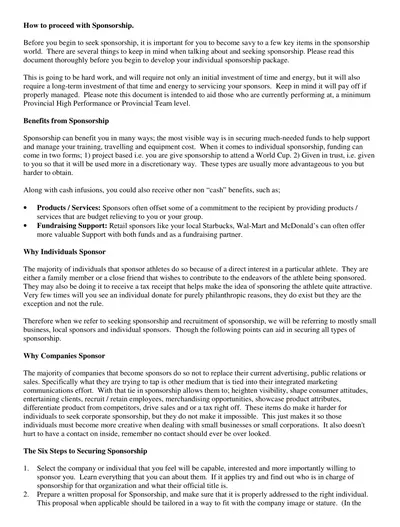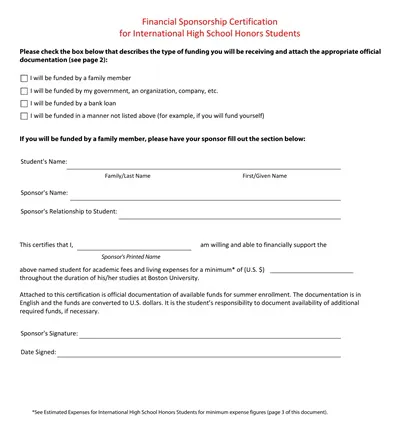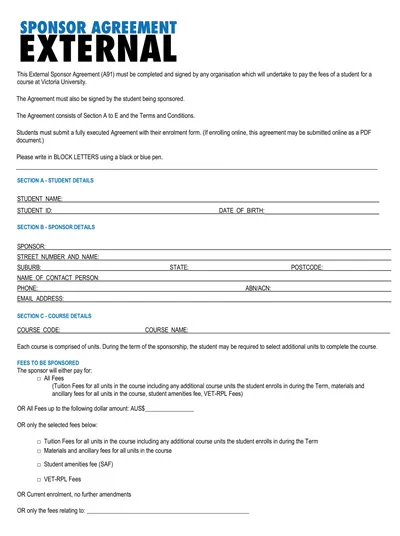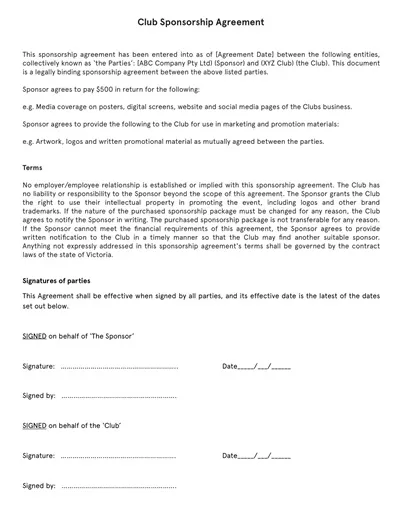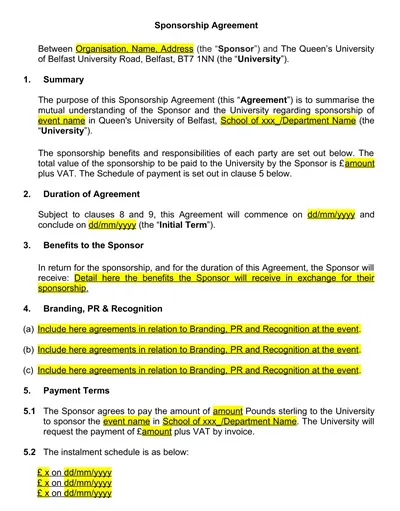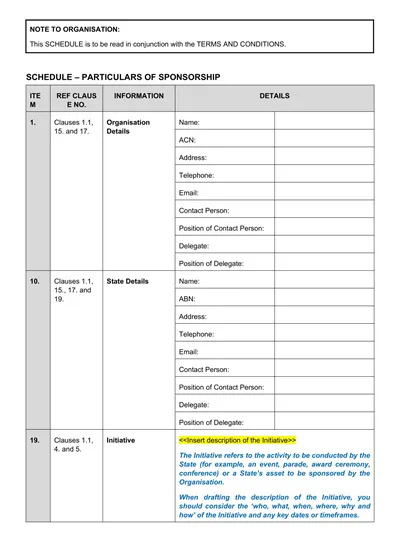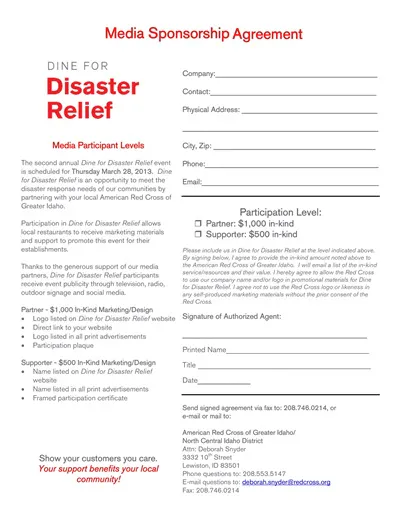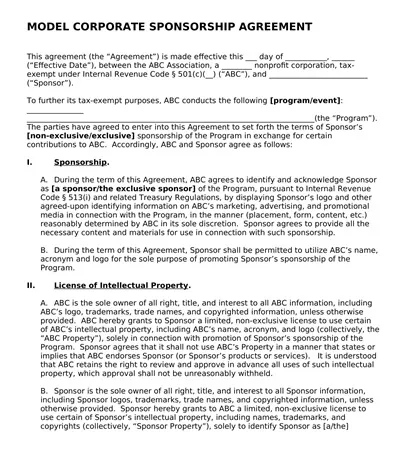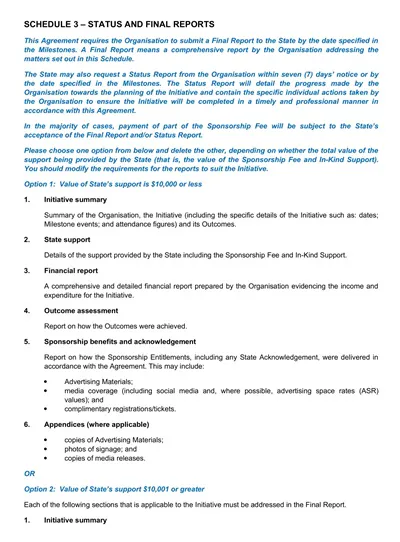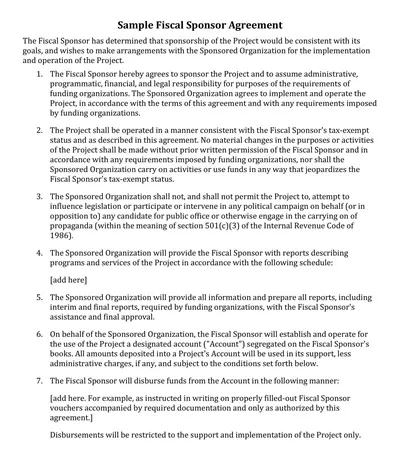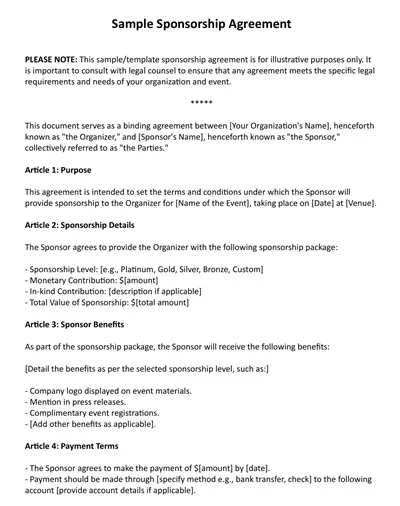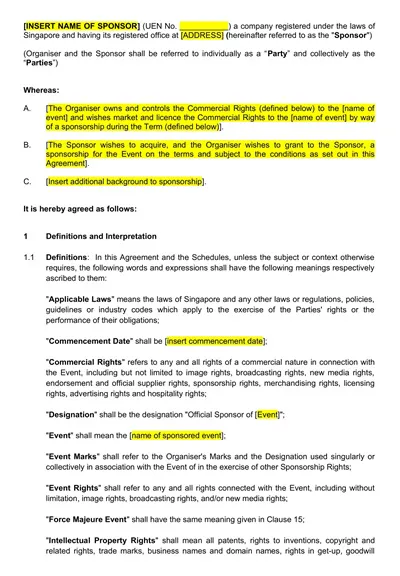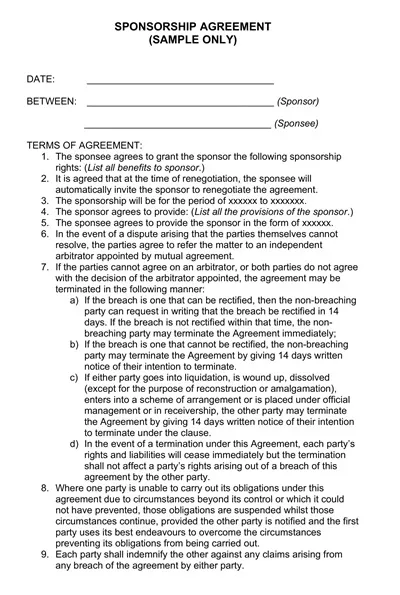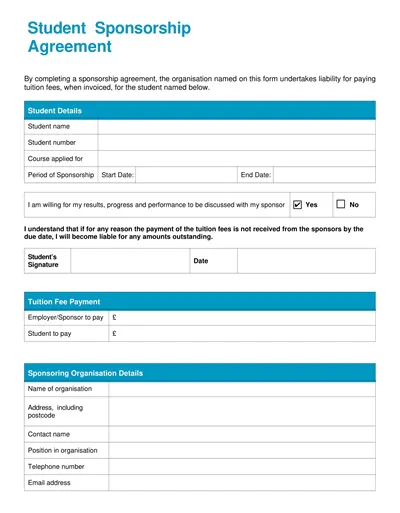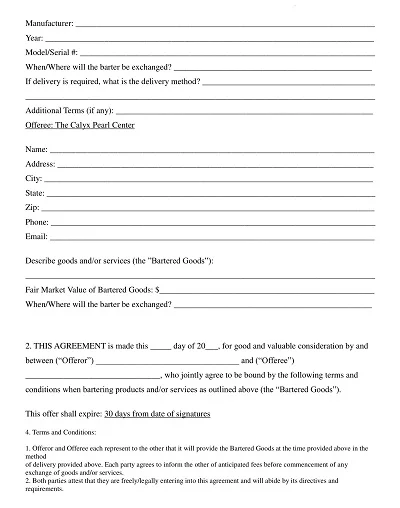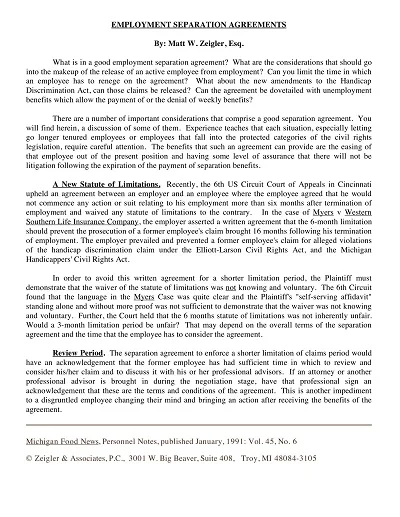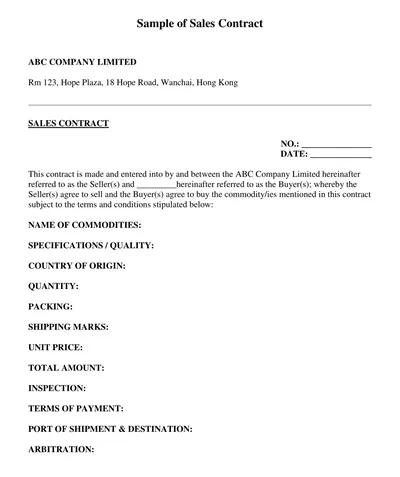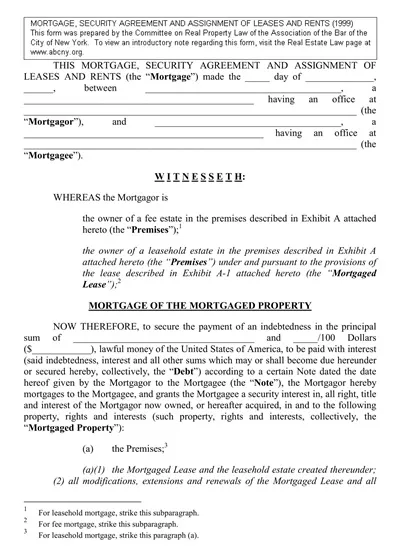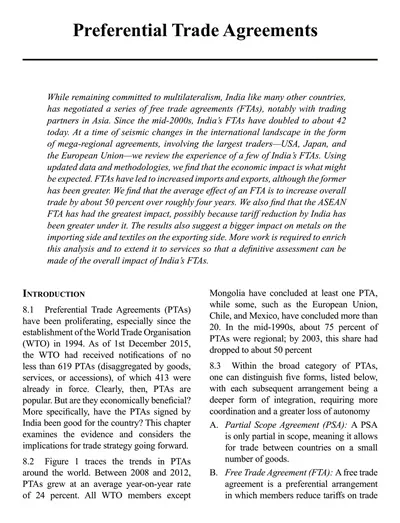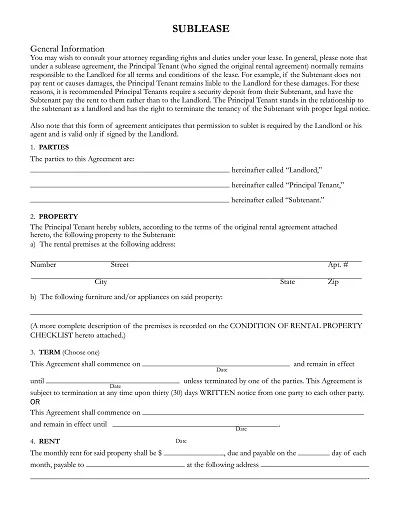Sponsorship Agreement Template is a plan document that lays down and describes the sponsorship arrangement between two or more parties. When drawing up this template, one is usually supposed to provide the goals and objectives of the sponsorship, the rights and responsibilities of the sponsor and beneficiary, the financial aspect of receiving the sponsorship as well as the period under which the agreement was made, and conditions that are relevant to the partnership.
Inasmuch as it creates a clear entity of the working arrangement, it is effective in making all the concerned parties realize their duties and heritage, thereby reducing conflict in the working relationship. It would thus suit the sponsorship arrangement of any generic nature across various industries or types of sponsorship events.
Download Free Simple Sponsorship Agreement Templates
What is a Sponsorship Agreement?
A sponsorship Agreement is a legal document between the sponsor and the sponsor, which can be an individual, organization, or event. It provides details of how sponsorship shall be requited with financial or material support in terms of rights of identification to be granted to the sponsor, for instance, in areas such as advertising.
This type of agreement formalizes obligations and responsibilities and guarantees that the sponsor will obtain a suitable contribution from the sponsored party. Enhancing the nature of the collaborative relationship is useful in defining and preserving the specific technical strategy of the two partners as well as the interests of every party in the entire course of the deal.
Types of Sponsorship Agreements
As in any other business partnership, sponsorship contracts may differ considerably because of the specific requirements of all the sponsors and sponsees. Common types of sponsorship agreements include:
1. Financial Sponsorship
This is probably the most common, where the sponsor makes financial contributions to the sponsored party in exchange for spaces to advertise or brand the event/promotion for whatever amount of time or coverage is agreed on.
2. In-Kind Sponsorship
In-kind sponsorship, on the other hand, is where the sponsor provides tangible resources to an event or a cause instead of cash.
3. Media Sponsorship
Media sponsors provide media services for advertising or promotional consideration in return for sponsorship rights. This may comprise coverage on television, radio, or online media, in addition to the prominent visibility of the event or campaign.
4. Product Sponsorship
Sometimes applied in athletic events or shows, this entails giving the sponsoring party products to use or exploit before consumers, thus, returning the recognition of the consumers.
5. Promotional Partnerships
They all relate to the sharing of marketing initiatives. They also coordinate promotional activity since both the sponsors will be supportive in sharing the effort and work towards adequate awareness of the messaging.
Both kinds of sponsorship agreements can be adjusted to ensure that they meet the objective of the sponsor and the beneficiary organization.
Key Elements of a Sponsorship Agreement
Sponsorship is another prominent strategy, and this should be well managed through the development of right legal contracts that will help define who does what. Key elements typically include:
- Parties Involved: The identity of the sponsor and the entity that is being sponsored must be well stated. This section should contain the donor’s full name as written on the identity card, together with the necessary contact information.
- Sponsorship Objectives: List the main objectives that are targeted by the sponsorship activity. This could mean brand visibility, clientele outreach, or participation in causes that affect society.
- Benefits and Deliverables: Outline how the sponsor will be promoted in relation to the project, for instance, including their brand or messaging on tickets to the event. Specify any commitment the sponsored party has to provide any deliverable of any kind.
- Payment Terms: Explain the financial conditions of the program, total sponsorship cash, frequency of the sponsorship, and any tax or charges imposed. This section should also discuss the non–monetary rewards as applied in an in-kind sponsorship situation.
- Duration and Termination: Identify when the sponsorship relationship starts and when it ends. Inserted provisions of renewal of the agreement or possibilities of terminating the agreement by exclusive consent of the partners.
- Rights and Obligations: Enumerate what is specially granted to the sponsor, for e.g., exclusivity or IP rights; what is expected of both camps when honoring the contract?
- Confidentiality and Non-Disclosure: Report any legal restrictions in order to safeguard any personal information in the course of the partnership and the future.
- Liability and Indemnification: Establish the behavior of who could be responsible for any liabilities that may exist either with regards to the agreement or various aspects affecting the operations of the business. This could be done by incorporating a provision for indemnity with a view to safeguarding the interest of the two parties.
- Dispute Resolution: Easy and flexible procedures for conflict resolution, like mediation or arbitration, must be included in case a conflict arises.
- Signatures: To validate the contract, the agreement has to be signed by the representatives of the parties.
This way, including these elements in the sponsorship agreement contributes to the development of a solid base of mutually beneficial agreements and a safeguard of interests.
Benefits of Sponsorship Agreements
There are a lot of benefits that partnership brings to the contracting parties because partnership sponsorship agreements provide legal bindings to relationships, which can yield success for both entities. From the side of sponsors, these agreements offer unique values of marketing exposure, where sponsors can promote their brands and gain more publicity to the target market.
As a result, sponsors can use occasion associations to enhance their company image, sustain consumer goodwill, and enhance their sales. On the other hand, sponsored entities are also able to get the primary monetary, service, or product requirements in order to fulfill their tasks, such as implementing an event, financing a project, or providing media exposure.
Such partnerships also help the conglomerate of the given sponsored entity to expand its attempts to pull publicity toward the sponsored entity and gain new supporters. In general, when sponsorship is done correctly, and both parties enter into a properly defined sponsorship contract, the agreement will help both parties work together, resulting in incredible synergy, and thus, the net effect will be more than the sum of the two parties put together.
Tips for Negotiating a Sponsorship Agreement
In sponsorship, it is important to understand the goals, who, what, and how of both parties, as well as make sure that both parties actually have a goal. Here are some tips to guide the process:
- Research and Know Your Worth: Do understand what benefit you are going to give to your potential sponsors if your organization or event is in question. Compile information that will help measure the target group, coverage, past performance, and probable performance in negotiations.
- Define Clear Objectives: Textually explain the objectives and what the sponsorship wants to gain from the sponsorship. This assists in establishing the seller’s requirements with the prospects of the sponsors and creates the right tone expected in the bargaining process.
- Be Open to Creative Solutions: Of flexibility, it is possible to say that it allows achieving newكيبtemplates and the results satisfying both partners. One should consider barter deals, besides pecuniary issues, which can also involve the deliveries of in-kind or co-marketing activities.
- Communicate Benefits Clearly: Emphasise the concern sponsors will gain, for example, visibility or reach out to the audience or improved corporate image. This is also important in order to relate to the sponsors with the issues that they care about.
- Establish Clear Roles and Responsibilities: Coordinate and explain company expectations about both parties’ sharers of the deal to avoid any form of confusion during the process.
- Be Prepared to Compromise: They require essential concessions by both adversaries. It is an essential condition that the sponsor should be ready to negotiate some factors while keeping the principle purpose and cost of sponsorship reasonably intact.
- Utilize Legal Counsel: Assist legal advice when it comes to terms so that he/ she can give feedback on legal issues pertaining to the agreement as well as whether the prepared document suits your needs.
- Build Strong Relationships: Negotiations must be regarded as the essence of building synergistic business relations. Building good rapport opens the door for multiple opportunities for future project collaborations and assistance.
It has been established that both parties can aim for this and other general goals and negotiate a mutually satisfactory solution that will lead to a successful and sustainable collaboration.
Why Do You Need to Incorporate Sponsorship Agreement Template
The use of a sponsorship agreement template can really help in reducing the time needed to come up with a formal sponsorship agreement between the parties involved. It keeps the document organized and also makes it easier to write since all information has to conform to a predetermined structure, steps that have to be followed, and areas that have to be covered, including the objectives, benefits, and legal aspects of a certain undertaking.
This not only saves time but also minimizes the failure to include some information that may cause future misunderstandings and conflicts. Negotiation should, therefore, be done from a template so as to avoid complications of formulating the structure of negotiations, while the organizations can then modify it to suit their needs. It is especially useful for small organizations or events that might not have a rich experience with lawyers because it offers a basic yet solid foundation that can be adjusted with the help of legal advice.
Besides, the sponsorship program may be accompanied by a professionally designed template which will add credibility to the organization’s sponsoring activities and provide reassurance to potential sponsors about the knowledge and capacities of the organization sponsoring it in order to arrange more smooth sponsoring cooperation.
How to Create a Sponsorship Agreement Template
Setting up a good format for the sponsorship agreement requires some prior planning and some effort to understand what aspects should be included. Here are the steps to develop an effective template:
Identify Key Components
An effective approach to creating such a template would be to note down all the essential elements that would have to be outlined in the template – the term of the sponsorship, fee, deliverables, sponsorship period, confidentiality provisions, liability clauses, and dispute resolution. Make sure these elements touch all the expectations of the two parties.
Draft a Clear Structure
Arranging all of the components on the list in a systematic and systematic manner. This makes it easy to read and, at the same time, makes sure that all the sections of the paper are well-highlighted for easy finding. When writing the text, it is better to use headings, subheadings, and bullets for a better understanding of the information.
Speaking and Writing Clarity
Construct each of them, actively avoiding the unnecessary use of oxides and other intersecting and complex expressions. One of the basic expectations when entering a partnership/relationship is that the roles, duties, and reciprocal rewards are well understood between partners/relationship.
Use Clear and Precise Language
Post examples of clauses that can be agreed upon, taking into consideration the then-specific demands of the agreement. This makes it possible to have one prepare for all possible eventualities at the same time so that nothing is left unnoticed.
Incorporate Legal Review
It is recommended to have a legal opinion on the chosen template before finalizing the choice or even using it. By engaging an independent attorney specialized in analyzing and drafting living trusts, this step serves to cut the best deal to both parties, and it validates the document legally.
Update Regularly
Update the template with changes in legal requirements, current practices, or demands from the organization. I believe that regular updates allow for their continual appropriateness in varying fields of sponsorship.
With the help of a sponsorship agreement template appropriate for further customization and based on the preferences of a specific organization, organizations achieve not only time-saving during the negotiation but also guarantee comprehensive legal coverage and efficient functioning of the sponsorship agreements.

